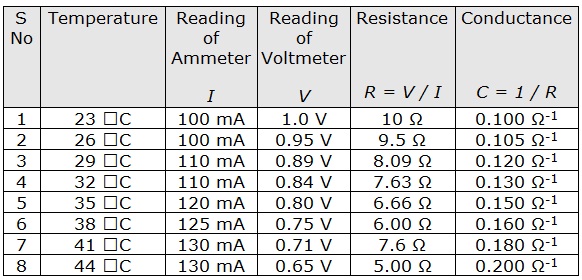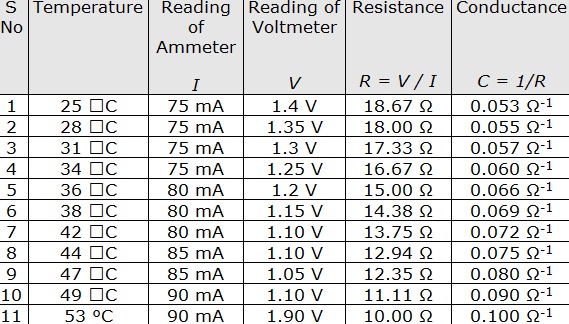





Published on Apr 02, 2024
To find the variation of conductance with temperature in electrolytes
Conductance: The property of ease of flow of electric current through a body is called conductance.
Resistance: The obstacle offered to the flow of electric current is called resistance.
Electrolysis: The operation in which electricity causes a chemical reaction is called electrolysis.
Ohm's Law: This law states that the current flowing through a resistance is directly proportional to the potential difference applied across it's ends, at constant temperature and pressure.
V = I x R
First Law: The mass of a substance produced or consumed in electrolysis is directly proportional to the quantity of charge passing through it.
m Q
or, m = Z × I × t
where, Z is electrochemical equivalent; I is current; t is time in seconds; Q is charge.
Second Law: The mass of substance produced in electrolysis directly proportional to its equivalent mass.
W1 / E1 = W2 / E2 = W3 / E3...
Third Law: The mass of a substance produced in electrolysis is directly proportional to the number of electrons per mole needed to cause desired change in oxidation state.
When voltage is applied to the electrodes immersed into an electrolyte solution, ions of electrolyte move, and thus, electric current flows through the electrolytic solution. The electrolytic solution and the metal conductors exhibit resistance to the passage of the current; both of which obey Ohm's law.
The reciprocal of resistance is called electrical conductance. The unit of electrical conductance is Siemens (S) or ohm-1 or mho.
If a solution is placed between two parallel electrodes having cross sectional area A and distance L apart then the resistance is given by
R = 1 / C
ρ (called 'rho') is known as resistivity. Its reciprocal gives the conductivity of the solution, which is denoted by κ (called 'kappa'). Its unit is Siemens/meter.
Κ = 1 / R * L / A
L / A is a fixed quantity for a cell and is called the 'cell constant'.
Factors Affecting Electrical Conductivity
The factors which affect the electrical conductivity of the solutions are:
Inter-ionic attraction: It depends on solute- solute interactions.
Solvation of ions: It depends on solute-solvent interactions.
Viscosity of the solvent: It depends on solvent-solvent interactions.
Glass beaker, CuSO4 solution, Cu electrodes, ZnSO4 solution, Zn electrodes, rheostat, battery eliminator, water, burner, thermometer, flask, ammeter, voltmeter
The electrolyte chosen is ZnSO4 and the electrodes are of Zn.
Readings for the measurement of conductance are taken at intervals of 3 degree Celcius.
Proper precautions are taken to avoid evaporation and to keep other factors constant.
The vessel and electrodes are removed and the vessel is cleaned and filled with ZnSO4 solution.
The electrodes are refitted in their original place so that the distance between them does not change.
Current is passed and when the voltmeter and ammeter show steady readings, they are noted.
The current is switched off.
It is seen that while the ammeter reading returns at once to 0 position. The voltmeter needle pauses for a while at a particular reading which is noted down.
This reading indicates the back EMF in the electrolyte.
Similarly, more sets of reading are taken, and resistance is calculated.
Thus, the value of conductance is calculated.
The switched on circuit readings in voltmeter and ammeter are taken.
The current through the electrolyte is changed by adjusting the rheostat and more sets of readings are taken.
Thus, the mean value of resistance is calculated.
Above steps are repeated for CuSO4 as electrolyte with electrodes made of Cu.
For the purpose of accuracy and convenience, some important aspects of the electrolyte process are kept constant in the experiment as their variation might affect the conductivity of the electrolyte. They are:
Voltage
Nature of electrodes
Size of electrodes
Separation between the electrodes
Concentration of the electrolytes
Nature of the electrolytes
Resistance in the circuit
For ZnSO4 electrolyte with Zn electrodes

For CuSO4 electrolyte

The relevant graph shows that the 1 / Resistance of an electrolyte increases at a steady rate as the temperature increases.
On heating a solution, it is known that viscosity gradually decreases, with decrease in viscosity, the speed and movement of the ions increases. In other words, the conductance of the electrolyte increases with increases in temperature. Hence, the result of the experiment agrees with reasoning.
Variation of resistance due to one of the factors should be kept constant.
The electrodes used in each case should always be kept parallel to each other.
The solution should be kept undisturbed throughout the experiment.
For each observation, three readings are taken and the mean value is considered
Chemistry (Part I) – Textbook for Class XII; National Council of Educational Research and Training
Concepts of Physics 2 by H C Verma; Bharti Bhawan (Publishers & Distributors)